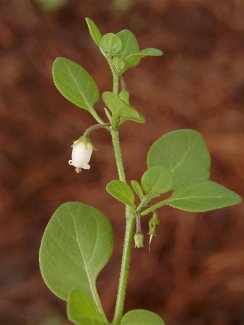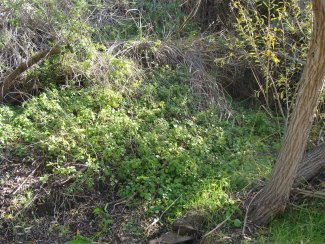Southern America
Brazil: Brazil - Rio Grande do Sul, - Santa Catarina
Southern South America: Argentina - Cordoba, - Buenos Aires, - Catamarca, - Chaco, - Corrientes, - Entre Rios, - Formosa, - Jujuy, - La Rioja, - Rio Negro, - Salta, - Federal District; Chile; Paraguay - Amambay, - Central, - Neembucu, - Paraguari; Uruguay - Rocha
Western South America: Bolivia - Cochabamba, - Chuquisaca, - La Paz, - Santa Cruz, - Tarija; Peru - Cuzco
A creeping herbaceous plant or woody vine with scrambling or trailing stems up to 3 m long, produced from a long-lived woody rootstock. Its small leaves may be borne in pairs or alternately arranged along the stems; leaves are borne in pairs are of unequal size, with the smaller ones being about three-quarters the size of the larger ones. Small white or cream-coloured tubular flowers (6-10 mm long) have five spreading petal lobes and are borne singly, or sometimes in pairs. Its fruit is a smooth yellow or whitish-coloured berry (10-20 mm long).
Exotic species on the list of prime candidates for Early Detection and Rapid Response action. (California Native Plant Society, Orange County Chapter).
A garden escape.
Naturalised in Victoria by 1919.
It was deliberately introduced from South Australia into Burnie, Tasmania as a food source for bees in the 1930's.



